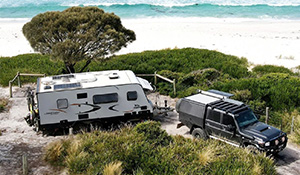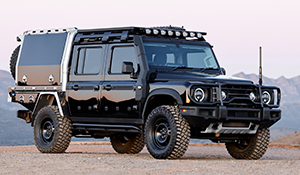ROAD TEST - Nissan Navara NP300 RX King Cab cab-chassis
The dual cab ST-X version of the new NP300 Navara led Nissan’s charge back into the Australian ute market in 2015. That was followed by the ST and then the “labourers” of the range, namely the DX and RX.
More recently (since this test was completed), the release of a ‘Series 2’ Navara saw Nissan drop the ‘NP300’ prefix, refine the dual cab’s suspension, fiddle with the model grades and add a new model grade – the SL – which sits between the RX and ST in terms of spec, features and price, but is only offered as a 4x4 dual cab.
We tested a Navara in RX in King Cab cab chassis format; an entry-level version that may not have all the bells and whistles of its ST-X sibling, but should have more than enough to keep tradies happy.

King RX
The RX King Cab 4x4 starts from $35,490 in cab chassis form ($36,990 for the pickup body) and is only available with a six-speed manual when selected in this guise. If you want an automatic, you’ll need to step up to the ST grade and its $46,490 starting price; a substantial leap. Estimated driveaway pricing for the RX King Cab cab chassis 4x4 is $41,340, compared to $48,086 for the ST manual pickup 4x4 and $50,666 for the ST with an auto.
The RX cab-chassis’ leaf-sprung back end automatically gives it more load-carrying muscle – and working class cred - than the coil-sprung models. It’s been given enough grunt to be competitive, too.
Like others in the current Navara range, the RX variants get the single turbo version of the 2.3-litre double overhead cam common-rail direct-injection intercooled turbo-diesel engine.

Producing 120kW at 3750rpm and 403Nm between 1500 and 2500rpm, it is down on the twin-turbo version in the SL, ST and ST-X that offers 140kW and 450Nm, but there’s a decent, useful spread of torque.
Despite a 1727kg kerb weight, low-speed work was an easy task during the test, with little fear of stalling.
The six-speed manual has a reasonably direct shift action and the clutch isn’t as vague as the steering, but the narrow gate on the gearbox does mean the odd wrong ratio.

Four Could Do With More
The Navara retains a part-time 4WD system for this version. It uses a rotary dial set-up that sporadically requires patience from the driver when going in and out of low range for hills and other low speed work around town or on the job site. Given the ground clearance is 217mm (less than a Subaru Forester), that patience would need to extend to any off-road antics, too.
There’s no option for on-road 4WD with the centre differential open - that becomes top of mind when driving in wet and slippery winter conditions. In locked four high it improves, but the standard fit road-biased rubber didn’t like muddy conditions. Even in the dry on a dirt road with the drivetrain in RWD, the Navara can spin up without masses of throttle.

The standard stability control system (which can be backed off but never completely deactivated) does the job without being too brutal in its intrusion, but the ability to run all four wheels on a sealed surface would be a handy feature, as would a standard rear diff lock.
A brake-operated limited slip diff function is installed instead, and it - with the traction and stability control - does a half-decent job in slippery and undulating conditions, but a mechanical lock doesn’t need wheel spin to work.
There’s also no hill start or descent control function within the electronic arsenal, but the latter in particular isn’t missed too much with low range.

Weighting and Hoping
The King Cab cab-chassis RX Navara we tested is both shorter and narrower than the dual cab model, measuring 5120mm long, 1790mm wide and 1770mm tall on a 3150mm wheelbase.
A payload of 1183kg is better than the show ponies of the segment and the leaf springs resist the urge for the RX to drag its rump along the road when heavily loaded.
What didn’t accompany the payload weight was a corresponding improvement in the RX’s ride quality - larger jumps and bumps were dealt with reasonably well, but with more secondary movement than you’d expect. Smaller road imperfections disturbed the RX to a greater extent than that which is becoming the norm in this segment.
As you’d also expect, the extra weight on the tail did nothing to improve what is sadly an already-vague front end, with light steering even when unladen.
An 11.8m turning circle is teamed with a slow steering ratio to make the Navara driver a busy pilot in twisty terrain.

Space Place
Being essentially an entry-level model, the low-spec cabin in the RX is sparse, but not without appeal for its intended duties, which would no doubt involve muddied or sandy footwear, as well as things like messy pets or dirt biking gear.
There is a robust feel to the cloth trim and plenty of in-cabin storage, including cleverly positioned cupholders beneath the outboard vents and phone pockets on the transmission tunnel.
The only complaint would be difficult door pocket access due to a robust door armrest.
The rear seat area, while designed for occasional use only, gets a tick with decent door storage and air vents - something many passenger cars with “proper” rear seating still can’t seem to manage despite ongoing criticism.

Those rear jump seats are well-cushioned, with the seat bases flipping up for more load space. If you’re in those rear seats, you won’t be able to raise or lower the side windows – they’re fixed – but there is a small electrically-operated sliding back window.
The back seats are easily accessed by the rear-hinged, forward-opening half-doors (which close and pair solidly), but only if you’re not hemmed in by other vehicles or obstacles.
Given the RX’s likely uses and the fact that the rear-seat area will more often see gear than people, the front and rear rubber mat sets to cover the carpeted floor area would be $220 well spent.

Spec, Safety and Service
Standard features on the RX Navara King Cab include manual air conditioning, a tilt-only plastic steering wheel with sound and phone controls, three 12 volt outlets, USB, auxiliary input and Bluetooth phone and audio link for the four-speaker sound system.
There’s also manual driver’s seat height adjustment, cruise control, remote central locking, power front windows and mirrors, 16 inch steel wheels (with a full-size spare), automatic headlights (which are underdone), intermittent wipers and a trip computer.
On test, we found the fuel economy from the 2.3 diesel to be far from gluttonous at 8.4lt/100km and not far from the claimed 6.6lt/100km ADR laboratory claim - quite an achievement given some of the low-speed crawling and load-lugging work we completed.
Adventurous types may bemoan there’s “only” an 80-litre fuel tank, but most others will have no reason for complaint, especially with that fuel economy.

Safety features for the five-star ANCAP-rated RX Navara ute include anti-lock brakes, seven airbags (front, front side, curtain and a driver’s knee airbag), stability and traction control, but no trailer sway control. As already mentioned, there’s no hill start or descent assist, either.
Nissan offers a three year, 100,000km warranty and capped price servicing on this latest generation Navara, which applies for up to six years or 120,000km for the 12 month/20,000km services, ranging in price from $525 to $711.
Has Lots, Needs More
The leaf-sprung Navara RX in King Cab form certainly feels more likely to lug a load without complaint, but also feels like it needs more attention from Nissan to bring it closer to the segment leaders.
The value proposition and sharp starting price are both good, with the RX sitting as much as $5,000 below some of the equivalent extra-cab versions, apart from the Triton.
Nissan makes the LCV 4x4 ute shopping list, but some buyers may find that the aggressive pricing (and free servicing offers) on the Triton, or the road manners and grunt of the Mazda BT-50 and Ford Ranger speak louder than the Nissan’s price.

2016 Nissan NP300 Navara RX King Cab cab chassis
ENGINE: 2.3lt YS23DDT direct-injection turbodiesel 4-cylinder
MAX POWER: 120kW @ 3,750rpm
MAX TORQUE: 403Nm @ 1,500-2,500rpm
TRANSMISSION: 6-speed manual
DRIVE: part-time 4WD
CONSUMPTION – COMBINED CYCLE: 6.6lt/100km
FRONT SUSPENSION: Independent double wishbone w/stabiliser bar
REAR SUSPENSION: Leaf spring
STEERING: R&P w/power assist
WHEELS: 16-inch steel Fr/Rr
TYRES: 2015 R16C Fr/Rr
SPARE WHEEL: Full-Size
BRAKES: Ventilated disc Fr/Drum Rr
SEATING CAPACITY: 4
LxWxH: 5120mm x 1790mm x 1770mm
WHEELBASE: 3150mm
GROUND CLEARANCE: 217mm
WADING DEPTH: 600mm
APPROACH/DEPARTURE/BREAKOVER ANGLE: 32.5/25.9/22.7 degrees
FUEL CAPACITY: 80lt
KERB WEIGHT: 1727kg
PAYLOAD CAPACITY: 1183kg
TOW CAPACITY: 3500kg braked
GVM: 2910kg
SAFETY RATING: ANCAP 5-Star
PRICE: $35,490 + ORCs
WARRANTY: 3yr/100,000 km
<a href="www.nissan.com.au">nissan.com.au</a>
Words: Stuart Martin
Photos: Stuart Martin and Nissan Australia



























